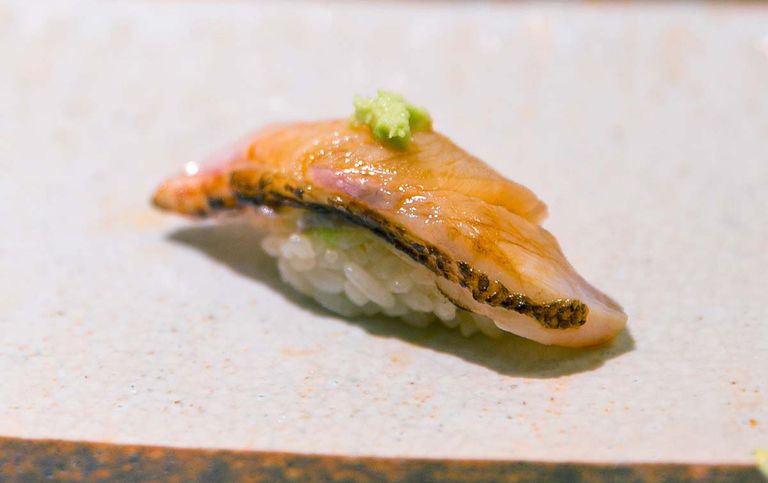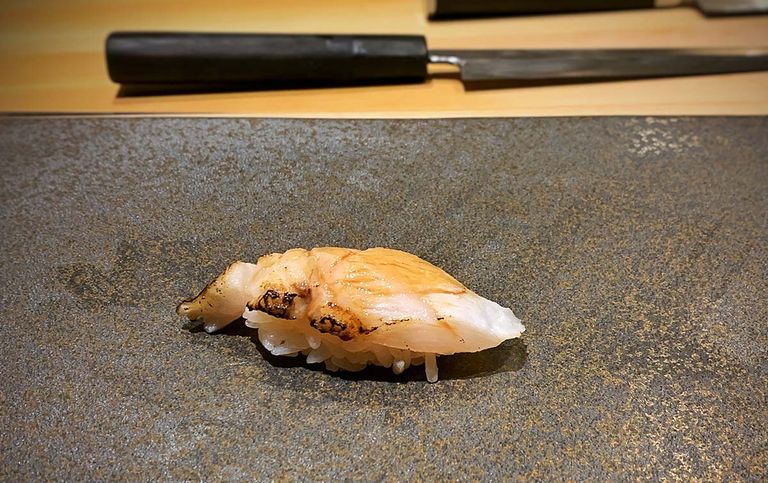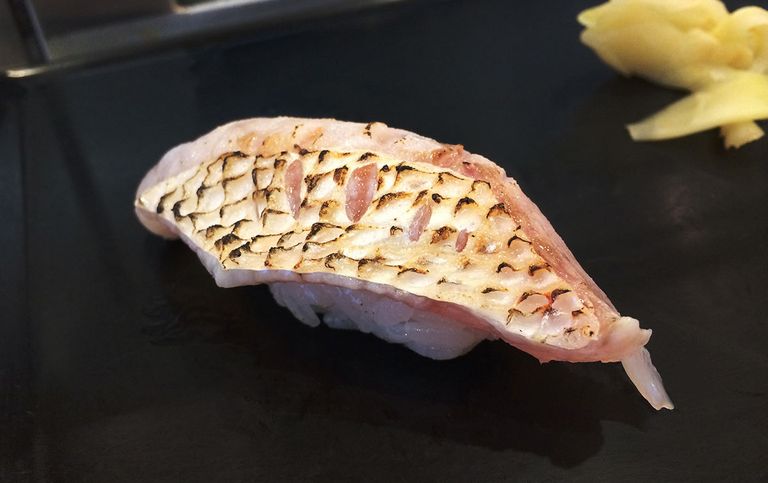Akamutsu Sushi
A Comprehensive Overview of Blackthroat Seaperch in Japanese Sushi Cuisine
アカムツ(ノドグロ)すし 、 赤鯥(喉黒)寿司 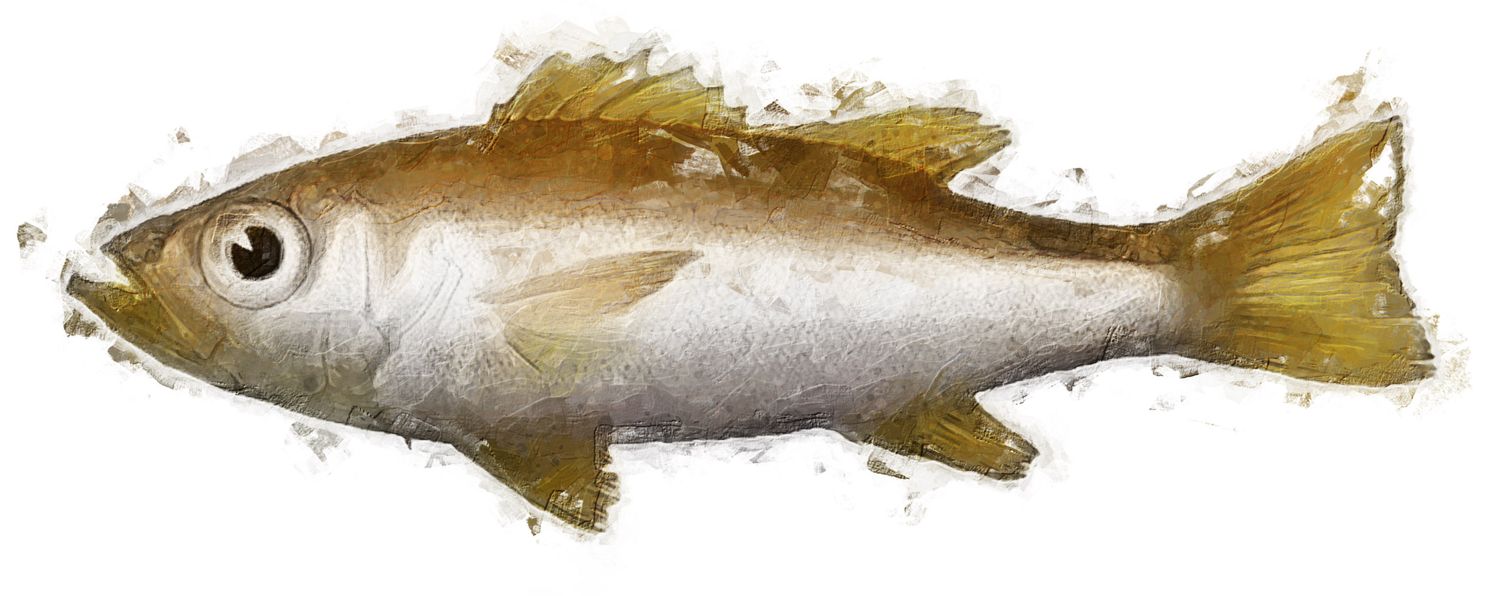
What is Akamutso or Nodoguro?
The blackthroat seaperch or rosy seabass is called akamutsu in Japan. The term mutsu (むつ) comes from the meaning of mutsukkoi (むつっこい, Tukushima dialect) and means in other words “greasy” or “strong in taste”. Besides the name akamutsu it also carries the very common name nodoguro (喉黒), which is similar to its English name blackthroat. Akamutsu belongs to the family of lantern bellies and is highly valued in Japan as a premium seafood and sushi ingredient. Some connoisseurs refer to its meat as “white toro”, which is said to be in no way inferior in taste and texture to the fatty meat of tuna.
Akamutso for Sushi or Sashimi
Akamutsu or nodoguro owes its first-class reputation as a gourmet fish to its remarkable high fat content. Under its skin is a distinctive layer of fat that gives the whitish meat a certain sweetness, hence its nickname “white toro”. Whether raw or cooked, its meat has a unique and elegant taste. The meat is soft and has a wonderfully full-bodied umami taste. It harmonizes very well with sushi rice and is therefore appreciated not only as sashimi but also as hand formed sushi (nigiri).
Best Season
Akamutsu is very tasty regardless of the season, but the best season is considered to be late winter to spring, before it spawns in late summer. The fish is fatty regardless of the season and is popular throughout Japan, especially in urban areas.
Akamutsu in Japan
In Hamada, a city in Shimane Prefecture on the Sea of Japan, akamutsu is known as nodoguro, a local specialty that is also regularly mentioned in tourist guides. Its name nodoguro, loosely translated as “blackthroat”, is due to the dark coloring on the back of its mouth. Akamutsu is mainly caught in the Sea of Japan, the side of Japan facing away from the Pacific Ocean, and is found along the coast from Toyama to Shimane. It is appreciated as a regional delicacy throughout the Hokuriku region.
Ecology of Akamutsu
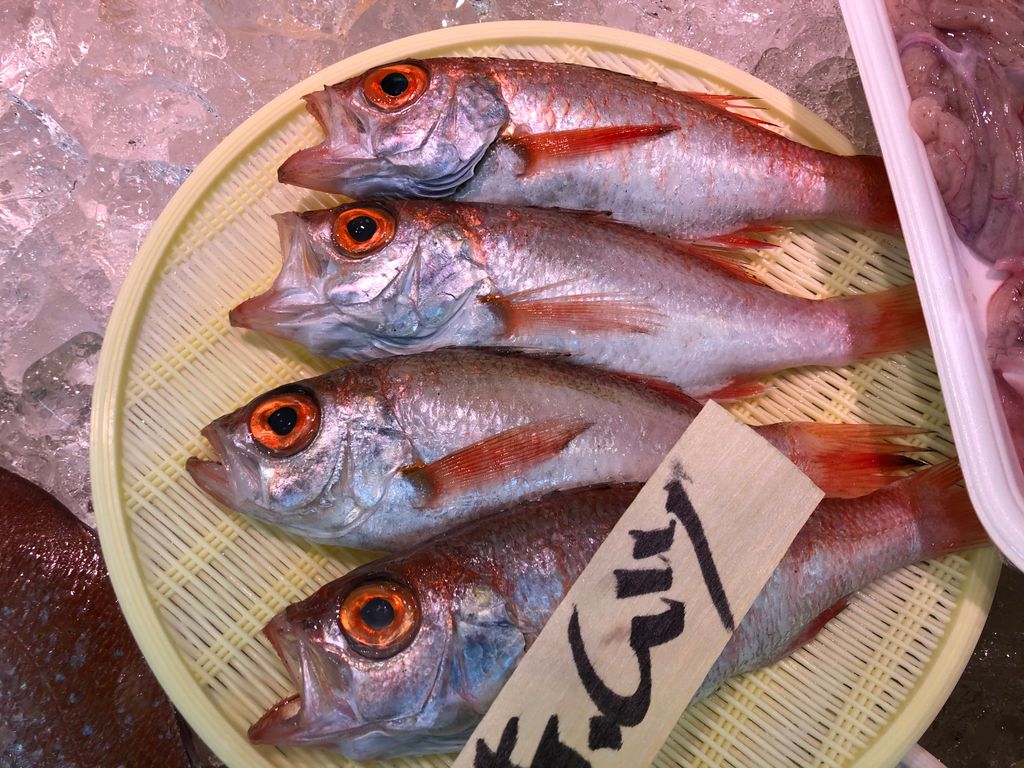
Totti. 市場で売られるアカムツ. wikimedia.org. Some rights reserved: CC BY-SA 4.0 DEED. Changes applied: brightness, contrast, noise, white balance
Akamutsu lives at sea depths of 100 to 600 m and feeds mainly on smaller fish as well as crustaceans and molluscs. The usual length is 30 cm, with a maximum of 40 cm. Its range extends from the Sea of Japan across the western Pacific to Australia.
It is characterized by its compact body, which is covered by a silver-grey to pinkish shimmering skin. The skin may be slightly reddish in places, giving it a hint of color. Particularly striking are the large, round eyes, which form a strong contrast to the rest of the body with their orange to red irises. The gills are bright red, which also indicates the freshness of the fish. The fins of the akamutsu are thin and delicate. Their color is red-orange and brightens towards the tips.
Economy of Akamutsu
Akamutsu is considered sensitive to changes in its living conditions. Fluctuating water temperatures and changes in the supply of food are said to have a significant impact on the quality of the catch. Top specimens of akamutsu are traded at comparatively high prices, it is not unusual for particularly good specimen to achieve prices of up to over ¥10,000 (≈ 95 USD) per kilo.
Aquaculture of Akamutsu
In July 2013, a research group from the Nihonkai-ku Fisheries Research Institute announced that akamutsu had succeeded in being raised in aquaculture for the first time, allowing them to be transferred to their natural habitat. In February 2017, it was confirmed that one of the released akamutsu juvenile fish was able to survive in the wild. The specimen was found as a by-catch in the net of a shrimp fisher. The discovery raises hopes for a more stable market supply and the protection of natural stocks. On the other hand, it was also observed that there are very few females among the adult fish raised by artificial insemination. These and other aspects are still the subject of current research.
Season Calendar for Akamutsu
The calendar shown does not provide information on fishing times, but marks the periods in which akamutsu is considered particularly tasty.
Warnings related to Akamutsu
Video about Akamutsu Sushi
External video embedded from: youTube.com. Credit イシ. のどぐろ(アカムツ)のさばき方~握り寿司とあら汁になるまで~how to fillet a Blackthroat seaperch and make sushi and soup.
Species of Akamutsu
The following species are regarded as authentic akamutsu. Either historically, according to the area of distribution or according to the common practice in today's gastronomy:
Sources and Further Reading
- [1]Seon Hee Choi, Jung Kim, Jin Ok Jo, Min Kyung Cho, Hak Sun Yu, Hee Jae Cha, Mee Sun Ock. Anisakis Simplex Larvae: Infection Status in Marine Fish and Cephalopods Purchased from the Cooperative Fish Market in Busan, Korea. Korean Journal of Parasitology 49 (1) 39-44. 2011
- Rainer Froese, Pauly Daniel. FishBase. The Leibniz Institute of Marine Sciences at the University of Kiel, FishBase.org, 2019. Source retrieved 12/24/2020
- 昌髙藤原. 『ぼうずコンニャクの市場魚貝類図鑑 (Bozu Konyaku's Market Fish and Shellfish Book)』. Bozu Konnyaku Co., Ltd., Tokyo ぼうずコンニャク株式会社東京, zukan-bouz.com、 2020. Source retrieved 12/27/2021
- 『放流ノドグロの生存確認 富山市沖で県水産研 (Confirmation of survival of released blackthroat seaperch Prefectural Fisheries Research Institute off Toyama City)』. hokurikushinkansen-navi.jp, Kitanippon Shimbun (北日本新聞), Toyama (富山市)、 2018-01-05. Source retrieved 12/24/2020
- 『カラー完全版 魚の目利き食通事典 (A Complete Color Dictionary for Fish Connoisseurs)』. Kōdansha (講談社) + α Bunko, Tokyo. 2002
- 望月賢二. 図説魚と貝の事典 (Illustrated fish and shellfish encyclopedia). Fish Culture Research Association (魚類文化研究会), Kashiwashobo Publishing (柏書房), Tokyo. 2005
- 水産総研. 『ノドグロ稚魚飼育成功/高級魚、安定供給へ期待 (Successful breeding of nodoguro fry, high-end fish expected to lead to stable supply)』. Shikoku News, shikoku-np.co.jp, The Shikoku Shimbun (四国新聞社), Takamatsu (高松市)、 2013-11-22. Source retrieved 12/24/2020
- IUCN Red List of Threatened Species. Version 2023-1
Image Credits
- SushiPedia. akamutsu. All rights reserved ©
- City Foodsters (Grace Chen, Jason Wang). Sushi Tokami, Tokyo. flickr.com. Some rights reserved: CC BY 2.0. Changes applied: brightness, contrast, noise, white balance
- SushiPedia. Akamutsu Aburi Nigiri Sushi. All rights reserved ©
- T.Tseng. Nodoguro, Sushi Amane, New York. flickr.com. Some rights reserved: CC BY 2.0. Changes applied: brightness, contrast, noise, white balance
- Totti. 市場で売られるアカムツ. wikimedia.org. Some rights reserved: CC BY-SA 4.0 DEED. Changes applied: brightness, contrast, noise, white balance
- City Foodsters (Grace Chen, Jason Wang). Nodoguro, Sushisho Masa, Tokyo. flickr.com. Some rights reserved: CC BY 2.0. Changes applied: brightness, contrast, noise, white balance

